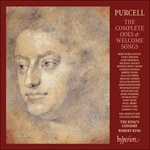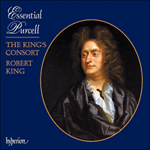
Welcome to Hyperion Records, a British classical label devoted to presenting high-quality recordings of music of all styles and from all periods from the twelfth century to the twenty-first.
Hyperion offers both CDs, and downloads in a number of formats. The site is also available in several languages.
Please use the dropdown buttons to set your preferred options, or use the checkbox to accept the defaults.

For his 1691 offering to the Queen Purcell was on sparkling form, with recent successes on the stage leading to a more expansive style of composition. Besides the usual strings, Welcome, welcome, glorious morn also required pairs of oboes and trumpets whose presence is felt right from the extrovert start of the Symphony, where the trumpets’ theme is thrown between the pairs of instruments before all join together, first in busy semiquavers, and then in the rich cadential figuration. The imitative section that follows continues in the same vein, with trumpets, oboes and strings answering each other. In the later Odes there is a more integrated style of composition, with sections flowing into each other with more freedom, and the opening demonstrates this as the tenor soloist, oboes and finally the chorus combine together. The duet ‘At thy return the joyful Earth’ leads into a glorious instrumental ritornello before the chorus returns, this time with the addition of two small duets. For the duet ‘Welcome as when three happy Kingdoms strove’ the mood changes to a more intimate style, but Purcell engineers an effective build-up to ‘the loudest song of Fame’. The tenor solo ‘The mighty goddess’ is an extraordinary piece of writing, with the soloist’s florid line contrasting with the insistent chordal string accompaniment. In the next section ‘Full of Wonder and Delight’ Purcell combines three elements, with a trio, a joyful chorus and finally the full instrumental ensemble joining in praise at the infant Queen Mary’s birth. ‘And lo! a sacred Fury’ is a compositional tour de force, with a dramatic recitative-style opening leading into the extended section ‘To lofty strains’, set over a remarkable dotted six-bar ground bass. The soloist’s line is finally taken up by the full vocal ensemble. Another short passage of semi-recitative, ‘My Pray’rs are heard’, this time for soprano, leads into a ground bass (treated freely in view of its brevity) and finally a chorus. The short bass duet ‘He to the Field by Honour call’d shall go’ and elegant tenor solo ‘Whilst undisturb’d his happy Consort reigns’ take us into the final solo and chorus. First a solo tenor and the two trumpets announce the theme, and then in augmented counterpoint the entire ensemble ends the work in triumphant vein.
from notes by Robert King © 2010
Pour son cadeau de 1691, Purcell tenait une forme éblouissante, de récents succès scéniques l’ayant conduit à adopter un style davantage expansif. Outre les habituelles cordes, Welcome, welcome, glorious morn exige des hautbois et des trompettes par deux, dont on ressent la présence dès le début extraverti de la Symphonie, quand le thème des trompettes est lancé d’une paire d’instruments à l’autre avant que tous se réunissent, d’abord en doubles croches animées puis dans la riche figuration cadentielle. La section imitative suivante est dans la même veine, trompettes, hautbois et cordes se répondant mutuellement. Les Odes tardives présentent un style plus intégré: les sections se coulent les unes dans les autres, plus librement, comme ici, dans l’ouverture, quand le ténor solo, les hautbois et, enfin, le chœur se combinent. Le duo «At thy return the joyful Earth» mène à un sublime ritornello instrumental avant le retour du chœur, augmenté, cette fois, de deux petits duos. Pour le duo «Welcome as when three happy Kingdoms strove», le climat se fait plus intime, malgré une impressionnante montée en puissance jusqu’à «the loudest song of Fame». L’extraordinaire solo de ténor «The mighty goddess» voit la ligne fleurie du soliste contraster avec l’insistant accompagnement de cordes, en accords. Dans la section suivante, «Full of Wonder and Delight», Purcell combine un trio, un chœur allègre et, enfin, l’ensemble instrumental au complet, tous s’unissant pour louer la naissance de la petite reine Marie. «And lo! a sacred Fury» est un tour de force compositionnel, avec une ouverture théâtrale en style récitatif, menant à la section prolongée «To lofty strains», sur un remarquable ground bass pointé de six mesures. La ligne du soliste est finalement reprise par toutes les voix. Un autre court passage de semi-récitatif, «My Pray’rs are heard», cette fois pour soprano, conduit à un ground bass (traité librement, vu sa brièveté), et, pour terminer, à un chœur. Le court duo de basses «He to the Field by Honour call’d shall go» et l’élégant solo de ténor «Whilst undisturb’d his happy Consort reigns» nous entraînent dans l’ultime solo et chœur. Un ténor et les deux trompettes annoncent le thème et c’est ensuite en contrepoint augmenté que l’ensemble au grand complet clôt l’œuvre dans une veine triomphante.
extrait des notes rédigées par Robert King © 2010
Français: Hypérion
Als er 1691 seine Ode für die Königin schrieb, befand Purcell sich in Hochform—die Erfolge, die er kurz zuvor mit seinen Bühnenwerken gefeiert hatte, inspirierten ihn zu einem weitläufigeren Kompositionsstil. Neben den üblichen Streichern ist Welcome, welcome, glorious morn mit jeweils zwei Oboen und Trompeten besetzt, deren Gegenwart gleich am extravertierten Beginn der Sinfonie zu spüren ist. Hier wird das Trompetenthema zwischen den anderen Instrumentenpaaren hin- und hergeworfen, bevor sie alle zusammenfinden, zunächst in geschäftigen Sechzehnteln und dann in reichhaltiger Kadenzfiguration. Im anschließenden imitativen Abschnitt führen Trompeten, Oboen und Streicher sozusagen eine Unterhaltung miteinander. In den späteren Oden ist der Kompositionsstil integrierter, wobei die jeweiligen Abschnitte freier ineinander übergehen; zu Beginn wird dies demonstriert, indem sich der Tenorsolist, die Oboen und schließlich der Chor zusammenschließen. Das Duett „At thy return the joyful Earth“ leitet zu einem herrlichen instrumentalen Ritornell über, bevor der Chor zurückkehrt, diesmal mit zwei zusätzlichen kleinen Duetten. Bei dem Duett „Welcome as when three happy Kingdoms strove“ ändert sich die Stimmung und der Stil wird intimer, doch Purcell gelingt trotzdem ein wirkungsvoller Aufbau hin zu „the loudest song of Fame“. Das Tenorsolo „The mighty goddess“ ist eine außergewöhnliche Komposition, in der die ausgeschmückte Gesangslinie des Solisten im Kontrast zur beharrlichen akkordischen Streicherbegleitung steht. Im nächsten Abschnitt, „Full of Wonder and Delight“, kombiniert Purcell drei Elemente—die Geburt des Königskindes Mary wird zunächst von einem Trio, dann einem freudigen Chor und schließlich dem vollständigen Instrumentalensemble bejubelt. „And lo! a sacred Fury“ ist eine kompositorische Glanzleistung, in der ein dramatischer, rezitativischer Beginn zu dem längeren Abschnitt „To lofty strains“ führt, der über einem bemerkenswerten punktierten, sechstaktigen Basso ostinato erklingt. Die Gesangslinie des Solisten wird schließlich vom gesamten Vokalensemble aufgenommen. Eine weitere kurze quasi-rezitative Passage, „My Pray’rs are heard“, diesmal für Sopran, leitet zu einem ostinaten Bass (der angesichts seiner Kürze frei gehandhabt wird) und schließlich zu einem Chor über. Das kurze Bassduett „He to the Field by Honour call’d shall go“ und das elegante Tenorsolo „Whilst undisturb’d his happy Consort reigns“ führen direkt zum letzten Solo und Schlusschor. Erst kündigen ein Solotenor und die beiden Trompeten das Thema an, und dann bringt das ganze Ensemble in augmentiertem Kontrapunkt das Werk zu einem triumphierenden Abschluss.
aus dem Begleittext von Robert King © 2010
Deutsch: Viola Scheffel
 Purcell: The Complete Odes & Welcome Songs Purcell: The Complete Odes & Welcome Songs‘A treasure house of shamefully neglected music. Over nine hours of wonderful invention … this major recording achievement must be an irresistibl ... ‘By any yardstick these are life-enhancing works’ (CDReview)» More |
 Essential Purcell Essential Purcell'Not to be missed… the gateway to an absolute treasure trove of delights' (BBC Music Magazine) 'Magnificent performances of Purcell masterpieces' (In Tune, Japan) 'This is the winner among inexpensive samplers, and highly recommended. Almost ... » More |

